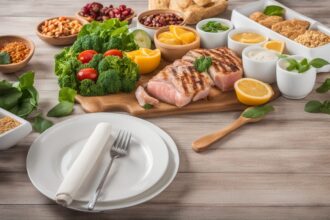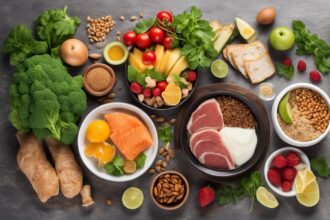Hey there, fellow wellness seekers! If you’re diving into the world of health fasting, you’ve likely heard about its potential benefits—improved metabolism, better mental clarity, and even weight management. But let’s be real: fasting isn’t just about skipping meals; it’s about nourishing your body with the right foods during eating windows to maximize those benefits. Whether you’re practicing intermittent fasting, a 5:2 diet, or another fasting method, planning balanced meals is key to sustaining energy and avoiding the dreaded hunger pangs. In this post, I’m sharing practical fasting meal ideas, backed by science, to help you thrive on your health fasting journey. Let’s dig into how you can eat smart and feel great while fasting!
What Is Health Fasting and Why Does Nutrition Matter?
For the uninitiated, health fasting refers to structured periods of abstaining from food or significantly reducing calorie intake, often with the goal of improving overall wellness. Popular methods include intermittent fasting (like the 16:8 approach, where you fast for 16 hours and eat during an 8-hour window) or alternate-day fasting. Research suggests fasting can promote cellular repair through autophagy and improve insulin sensitivity (Mattson et al., 2017). However, without proper nutrition during eating periods, you might miss out on essential nutrients, leading to fatigue or cravings. That’s why crafting nutrient-dense meals for fasting health benefits is so important—it’s not just about when you eat, but what you eat.
Key Nutritional Principles for Fasting Meal Planning
When you’re on a health fasting plan, your body needs foods that provide sustained energy, support muscle maintenance, and keep you satiated. Focus on a balance of macronutrients—proteins, healthy fats, and complex carbohydrates—while prioritizing hydration and micronutrients like vitamins and minerals. Studies show that adequate protein intake during fasting windows helps preserve lean muscle mass (Tinsley & La Bounty, 2015). Additionally, incorporating fiber-rich foods can stabilize blood sugar levels, preventing energy crashes. Let’s break down some core principles to guide your fasting meal prep for optimal fasting wellness.
- Prioritize Protein: Include lean meats, eggs, or plant-based options like lentils to support muscle repair and keep you full longer.
- Choose Healthy Fats: Avocados, nuts, and olive oil provide energy without spiking blood sugar.
- Opt for Complex Carbs: Quinoa, sweet potatoes, and whole grains release energy slowly, avoiding hunger spikes.
- Stay Hydrated: Water, herbal teas, and electrolyte-rich drinks are crucial, especially during fasting hours.
Breakfast Ideas to Break Your Fast
Breaking your fast with a nutrient-packed meal sets the tone for the day, especially if you’re following an intermittent health fasting schedule like 16:8. The goal is to replenish your body without overloading it. Research indicates that a balanced breakfast can improve cognitive function and energy levels after fasting (Benton et al., 2016). Here are a few easy ideas to kickstart your eating window with fasting-friendly nutrition.
- Avocado Toast with Eggs: Whole-grain toast topped with mashed avocado and a poached egg offers healthy fats, protein, and fiber. Sprinkle some chia seeds for an omega-3 boost!
- Greek Yogurt Parfait: Layer Greek yogurt with berries and a handful of granola for a mix of protein, antioxidants, and slow-digesting carbs.
- Vegetable Omelet: Whip up a three-egg omelet with spinach, tomatoes, and feta cheese for a low-carb, high-protein start.
- Chia Pudding: Mix chia seeds with almond milk and let it sit overnight. Top with nuts and fruit for a hydrating, fiber-rich meal.
- Smoothie Bowl: Blend spinach, banana, and protein powder with almond milk, then top with pumpkin seeds and shredded coconut for texture.
Lunch and Dinner Options for Sustained Energy
During your eating window, lunch and dinner should focus on keeping you full and energized, especially if you’re active or have a busy day. A study by the American Journal of Clinical Nutrition highlights that balanced meals with adequate protein and fiber can reduce overeating later (Leidy et al., 2015). For those on a health fasting diet, these meals are your chance to pack in nutrients without feeling deprived. Here are some hearty yet healthy ideas to support your fasting lifestyle health goals.
Try a Grilled Chicken Quinoa Bowl: Combine grilled chicken breast with cooked quinoa, steamed broccoli, and a drizzle of olive oil for a balanced mix of protein, carbs, and fats. If you’re vegetarian, swap the chicken for chickpeas or tofu. Another great option is a Salmon and Sweet Potato Plate: Bake a salmon fillet with a side of roasted sweet potato wedges and sautéed kale for omega-3s and antioxidants. For something lighter, go for a Mediterranean Salad: Toss mixed greens with cucumbers, cherry tomatoes, olives, feta, and grilled shrimp, dressed with lemon and olive oil. These meals are versatile and align perfectly with a healthy fasting routine.
Snacks to Support Your Fasting Goals
Snacking during eating windows can be a lifesaver if you’re feeling peckish, but it’s important to choose wisely. The right snacks can prevent blood sugar dips and keep you on track with your health fasting plan. According to the Mayo Clinic, small, nutrient-dense snacks can complement fasting without derailing progress (Mayo Clinic, 2020). Stick to portion-controlled options that combine protein or fat with a bit of fiber to avoid mindless munching.
Common Pitfalls to Avoid with Fasting Meals
While health fasting offers numerous benefits, it’s easy to make mistakes when planning meals. One common issue is overeating during eating windows, which can negate the calorie deficit fasting creates (Johnstone, 2015). Another is relying on processed foods or sugary drinks, which can spike insulin levels and counteract fasting health advantages. Be mindful of portion sizes, and avoid “rewarding” yourself with junk food after a fast—your body deserves better! Also, don’t skimp on hydration; dehydration can mimic hunger and sap your energy. By focusing on whole, unprocessed foods and listening to your body, you’ll set yourself up for success in your fasting for health journey.
As we wrap up, remember that health fasting is a personal journey, and there’s no one-size-fits-all approach to meal planning. The fasting meal ideas shared here—from protein-packed breakfasts to hearty dinners—are designed to fuel your body and enhance the benefits of your healthy fasting lifestyle. Experiment with these recipes, tweak them to your tastes, and pay attention to how your body responds. Fasting isn’t just about restriction; it’s about mindfulness and nourishment. So, take it one meal at a time, stay hydrated, and celebrate the small wins along the way. Here’s to a healthier, more energized you through fasting wellness!
References
- Benton, D., Slater, O., & Donohoe, R. T. (2016). The influence of breakfast on cognitive performance. Appetite, 103, 1-7.
- Johnstone, A. (2015). Fasting for weight loss: An effective strategy or latest dieting trend? International Journal of Obesity, 39(5), 727-733.
- Leidy, H. J., Clifton, P. M., Astrup, A., et al. (2015). The role of protein in weight loss and maintenance. American Journal of Clinical Nutrition, 101(6), 1320S-1329S.
- Ageing Research Reviews, 39, 46-58.
- Mayo Clinic. (2020). Intermittent fasting: Does it have health benefits? Retrieved from https://www.mayoclinic.org
- Tinsley, G. M., & La Bounty, P. M. (2015). Effects of intermittent fasting on body composition and clinical health markers in humans. Nutrition Reviews, 73(10), 661-674.






